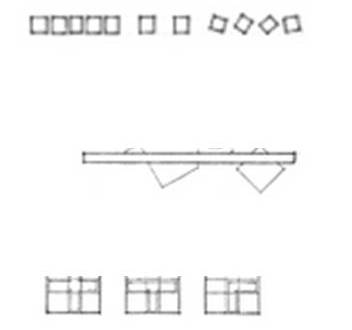- FORUM
- PROJECTS
- ABOUT US
- RESOURCES
- CONTACT US
- FORUM
- PROJECTS
- ABOUT US
- RESOURCES
- CONTACT US
Proportion and scale are closely interrelated. Scale alludes to the size of something compared to a reference standard or to the size of something else. Proportion refers to the proper or harmonious relation of one part to another or to the whole.
A proportioning system establishes a consistent set of visual relationships between the parts of a building, as well as between the parts and the whole.
A number of theories of “desirable” proportions have been developed in the course of history. They include; Golden Section(ratio), Classical Orders, Renaissance Theories, Modular, Ken, Anthropometry, and Scale.
Golden ratio
Two quantities are in the golden ratio if the ratio of the sum of the quantities to the larger quantity is equal to the ratio of the larger quantity to the smaller one.


The first example of the golden ratio in the average human body is that when the distance between the navel and the foot is taken as 1 unit, the height of a human being is equivalent to 1.618
Some other golden proportions in the average human body are:
- The distance between the finger tip and the elbow / distance between the wrist and the elbow,
- The distance between the shoulder line and the top of the head / head length,
- The distance between the navel and the top of the head
- the distance between the shoulder line and the top of the head
- The distance between the navel and knee / distance between the knee and the end of the foot.
Principles of Architecture

Axis
A Line established by two point in space about which form and spaces can be arranged in symmetrical and balanced manner
Symmetry
The balanced distribution and arrangement of equivalent forms and spaces on opposite sides of dividing plane or about a center axis
Hierarchy
The articulation of importance and significance of form or space by its size shape and placement relative to other forms and spaces of organization
Rhythm
Unifying movement characterized by patterned repetition or alteration of formal elements or motifs in same or modified forms
Datum
A line plane or volume that , by its continuity and regularity , serves together , measure and organize a pattern of form and spaces.
Transformation
The principle that an architectural concept or organization can be retained, strengthened and built upon through a series of discrete manipulation and transformations.

Rhythm Datum Transformation Principles of Architecture
Axis

INDUCE MOVEMENT
The axis is a linear condition , it has qualities of length and direction and induce movement and views along its path
Termination At Both Ends
Reinforced By Defining Edges
Established By Symmetrical Arrangement
Slide Show Presentation
Forum Threads
Register & Download PDF for Educational Purposes Only

Register as member and login to download attachment [pdf] by right-click the pdf link and Select “Save link as” use for Educational Purposes Only
Disclaimer
Information on this site is purely for education purpose. The materials used and displayed on the Sites, including text, photographs, graphics, illustrations and artwork, video, music and sound, and names, logos, IS Codes, are copyrighted items of respective owners. Front Desk is not responsible and liable for information shared above.
